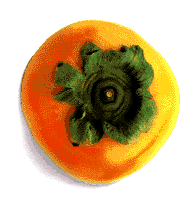 Apples Apples
Apples
should have smooth, firm, unbroken surfaces free of bruises and blemishes.
Some apples may have a brownish freckled surface on skin, usually caused
by weather, but flavor is unaffected.
To keep
apples crisp, store refrigerated, in a plastic bag (to retain moisture).
To determine
ripeness of apples in order to pick them from the tree, the following indices
of maturity are known:
1. Days
from full bloom. This is relatively constant from year-to-year in stable
climates, but not as good where climate can vary greatly from year to year.
Some cultivars mature in as little as 100 days, where others may take 180-210
days.
2. Flesh
firmness. Apples soften as they mature, so the force which results in flesh
yielding is a worthy criterion for ripeness (pressure tester).
3. Soluble
solids. This measures the sugar content of the juice, which increases as
apples ripen. Alone, this is an unreliable indicator since many factors
influence sugar content. It is used in conjunction with days from full
bloom to determine maturity.
4. Starch
test. Starch is broken down into sugars during ripening, and a quick iodine
stain test on a half-cut apple can be used to indicate how far along this
process has occurred. Often used on stored apples to assess remaining shelf-life.
For more
information on apples click
here.
 Apricots Apricots
Choose apricots that have a
beautiful blush and are firm in texture. Apricots are orange-yellow when
ripe. If you want to ripen immature apricots, keep them in a brown paper
bag. Keep them at room temperature until they are slightly soft.
Storage: one week, refrigerated.
To determine
ripeness of apricots in order to pick them from the tree, the following
indices of maturity are known:
1. Firmness is a reliable
indicator, as for plums. Apricots for fresh consumption are picked firm-mature,
since they are far too soft for shipping if allowed to approach ripening
on the tree. It is said that proper flavor never develops in fruit picked
prior to physiological maturity.
2. Days from full bloom is
a fairly reliable index given the relatively invariable growing conditions.
For more
information on apricots click
here.
 Nectarines - see peaches. Nectarines - see peaches.
 Peaches Peaches
If you buy peaches look for
ones with a creamy to gold undercolor that indicates ripeness. The amount
of red on peaches depends on the variety, it is not always a sign of ripeness.
Find fruits that have a well-defined crease and a good fragrance. Peaches
with a green undercolor are not ripe and will not ripen because peaches
and nectarines only ripen well on the tree. Peaches are ripe when
they give to gentle palm pressure. Green coloring indicates immaturity.
Shriveling at the stem end or excessive softening are indications of overripe
peaches.
You can keep peaches and nectarines
for one to three days but you have to be very careful, one small bruise
and it will go bad on that spot.
To determine
ripeness of peaches and nectarines in order to pick them from the tree,
the following indices of maturity are known:
1. The best index for peach
today is ground color; red color is a function of cultivar and light exposure
and therefore not a good index. Color "chips" were developed at Clemson
University, which are standard colors painted onto cards, used to train
harvesters. Ground color of fruit changes from green to straw-yellow during
ripening, and fruit that match color chip 3 (out of 6) are mature enough
for harvest. Fruit picked too early ( chip 2) never develop full flavor
and texture, and may develop a condition called woolly texture or woolliness,
characterized by mealy texture, and the absence of juice or flavor.
2. Firmness and days from
bloom can also be used to estimate maturity.
For more
information on apricots and nectarines click
here.
 Pears Pears
To check
for ripeness press gently near the stem end. If it yields slightly, it's
ripe.
Pears
are one of the unique kinds of fruits that ripen best off of the tree.
If allowed to ripen before they are harvested, their smooth, delicate flesh
often becomes 'gritty'. If you have to ripen the fresh pears that you purchased
put them in a fruit bowl or paper bag at room temperature. Not all pears
turn yellow as they ripen. Aside from Bartletts, which turn from green
to bright yellow, or Red Bartletts that change to a bright crimson color,
most pears show little or no change in color as they ripen.
To determine
ripeness of pears in order to pick them from the tree, the following
indices of maturity are known:
1. European
pears are harvested when "firm mature", stored immediately, and then allowed
to ripen for several days prior to fresh consumption. When fully ripe,
European pears have the typical "melting" flesh texture, and full development
of flavor. Asian pears however, are similar to apples, and are harvested
closer to physiological ripeness, and placed in cold storage. Flesh firmness
is the single most reliable indicator of pear maturity. Firmness in the
range of 10-15 lbs as measured by a pressure tester is desirable for most
cultivars. This is often combined with days from full bloom or degree days
for greater accuracy. In lieu of a pressure tester, one may observe when
fruit lenticels turn from white to brown, and when skin color begins to
lighten; at this stage, pears can be picked without shriveling.
For more
information on pears click
here.
 Persimmons Persimmons
Choose
smooth brightly-colored Persimmons that are plump. Ripen at room temperature and store refrigerated for several days. Then
simply rinse, peel and slice.
 Plums Plums
Choose plums that have a beautiful
blush and are firm in texture.
Storage.
Plums have similar storage characteristics and problems as peaches, cherries,
and apricots. They can be stored from 2-3 weeks at 32 F and 90% RH.
For more
information on plums click
here.
|